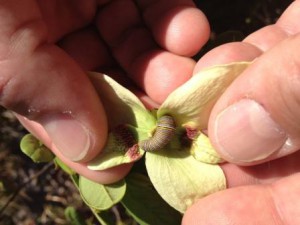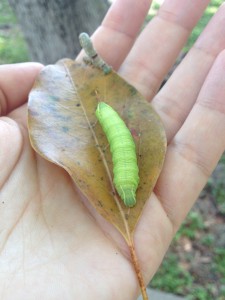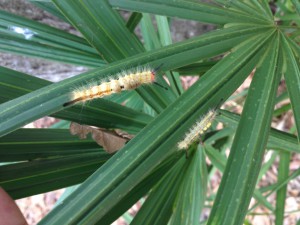A lot is happening in the natural world in spring. Flowers are blooming, new leaves are unfolding, birds are calling, and baby animals are being born. Another event also happening that can easily be missed unless you are specifically looking for it is the emergence of caterpillars! Below are some recent sightings in Pinellas County:
Monarch Caterpillars
Monarch caterpillars mostly feed on the milkweed plant (Asclepias spp.). As they feed on the milkweed, the caterpillars accumulate toxins from the plant which remain in their bodies even as adults. This toxin is not appealing to many predators and thus serves as a protection for these insects. These caterpillars are very distinct with rings of yellow, black and white and what look like long, black antenna on both ends of the body.

Zebra Swallowtail Caterpillars
The Zebra Swallowtail caterpillar feeds on the leaves of a plant called pawpaw (Asimina spp.) which has very distinct creamy colored flowers this time of year. These caterpillars are similar looking to the Monarch caterpillars described above, but rings of color are more varied like zebra stripes (hence the name) and lack the long antenna-like structures.

Sphinx Moth Caterpillars
These caterpillars are often referred to as “hornworms” because they almost always have a large “horn” or what looks like a spike at the end of their body. There are a variety of sphinx moth caterpillars, but they are all quite large and typically pale green in color with different version of spots along the side and sometimes a pattern of lines along the body either diagonally or horizontally.

Eastern Tent Caterpillar
These caterpillars’ tents or webs are often times noticed before the caterpillars themselves. Their webs are designed as a form of protection for a large number of Eastern Tent Caterpillars. They will leave the webs at night to feed on the leaves of plants and then return to “hangout” in the tent for protection during the day. The caterpillar is very hairy, but has beautiful coloration, often times including an almost iridescent blue. The webs are similar to those of spiders, made of silk and are typically formed around branches of trees. Don’t confuse these caterpillars and their webs with the Fall Webworm. The webs of Fall Webworms cover the entire tree and this typically occurs in the autumn.

Tussock Moth
Tussock moth caterpillars can vary in color but have four distinct dense, tufts of hair along their back with longer hairs surrounding the rest of the body. They also have two very long, black “hair pencils” which appear like antennae and a more fluffy projection of hair on their back end looking like a tail. Tussock moths are known for feeding on oak trees which are abundant throughout the state.

There is a lot to keep your eyes out for this spring. If you want to discover the world of caterpillars, you will have to do a little extra searching. Take a closer look at the trees and plants in your yard or visit a local park to see what you can find. Unsure of what you are looking at? That’s what I’m here for…snap a picture and send it my way: lara317@ufl.edu.
Stay up to date on news and information affecting our environment by following your UF/IFAS Pinellas County Natural Resource Extension Agent on Twitter or Facebook.
Find out about upcoming programs at our UF/IFAS Extension satellite office, Brooker Creek Preserve by liking us on Facebook.
 0
0
